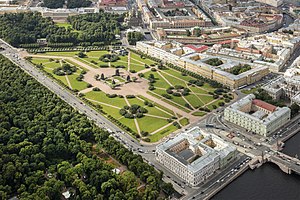The Monument to the Fighters of the Revolution (Russian: Памятник Борцам Революции) is a memorial on the Field of Mars in Saint Petersburg. It marks the burial places of some of those who died during the February and October Revolutions in 1917, and casualties who died between 1917 and 1933 in the Russian Civil War or otherwise in the establishment of Soviet power. It contains the first eternal flame in Russia.
The Field of Mars was selected by the Petrograd Soviet as the site for the ceremonial burials of those who had died during the February Revolution, which had toppled the tsarist autocracy. 184 bodies were interred in communal graves at the centre of the field, and a competition was announced for the design of a monument to those buried there. The competition was won by architect Lev Rudnev and consisted of granite walls forming the corners of a square enclosing a central space. Other prominent figures in the early Soviet government, and those who had died fighting to establish Soviet power, were buried on the site, as were those who died during the October Revolution. The monument, and the Field of Mars in general, became a pantheon to those who had died in the service of the state. Large granite tablets at the end of each wall carried epitaphs by People's Commissar of Education Anatoly Lunacharsky, extolling the virtues and sacrifices of those buried there. The Field of Mars was for a time renamed the "Victims of Revolution Square", and was sometimes called "The Square of the Graves of the Victims of the Revolution".
Burials ceased after 1933, though the monument continued to be developed. Used for vegetable gardens and the site of artillery batteries during the siege of Leningrad, the name "Field of Mars" was restored in 1944, and the square was repaired after the war. The central space of the memorial, which had been covered with a circular lawn and floral displays, was replaced with a paved square in the late 1950s, with the first eternal flame in Russia at the centre, lit in 1957. The flame has been used as the source of eternal flames elsewhere in the city and in Russia, including the Tomb of the Unknown Soldier near the Moscow Kremlin Wall.
© MMXXIII Rich X Search. We shall prevail. All rights reserved. Rich X Search


